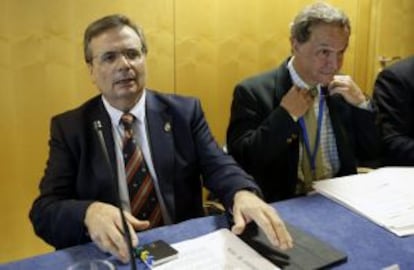Spain to research HIV cure using umbilical cord blood
Barcelona man who received experimental therapy was free of virus after three months

The National Transplant Organization (ONT) and the Spanish Hematology and Hemotherapy Society (SEHH) have launched a joint project to see if the HIV virus can be eliminated by carrying out stem cell transplants on patients who also suffer from cancers of the blood or bone marrow.
The idea is to improve the study of the method that has so far led to the only known case of someone being cured of HIV: Timothy Ray Brown, a US citizen known to the medical world as The Berlin Patient, who has been free of the virus for four years following a hematopoietic stem cell transplant, despite being off antiretroviral medication.
ONT director Rafael Matesanz said they would search Spanish umbilical cord banks for high-quality samples with a mutation in a receptor called CCR5 delta32. This protein is one of the “locks” that HIV picks open in order to infect the lymphocytes, explained Javier Martínez of IrsiCaixa, a center specializing in HIV treatment. “It’s the same thing that was done with the Berlin Patient.”
In September 2013, a 37-year-old Barcelona man submitted to the same experimental treatment, said Rafael Duarte, director of the Hematopoietic Transplant Program at the Catalan Cancer Institute. This patient had “an aggressive lymphoma as well as HIV.”
Following the transplant, weekly tests for the presence of the virus were carried out over three months. The last test “demonstrated that the virus had been eliminated,” said Duarte. In fact, cells extracted from the Barcelona patient showed that they were now protected against HIV because they failed to get infected in the presence of the pathogen. Unfortunately, the patient died and the experiment came to a halt.
Spain’s umbilical cord blood banks contain around 60,000 samples, said Marta Torrabadella, who works at the Barcelona bank. Researchers will select the 22,800 best samples and seek out those with the CCR5 delta32 mutation on both DNA copies (the mother’s and the father’s). This mutation occurs in slightly over one percent of Europeans, meaning that around 250 samples could potentially be found, said Torrabadella.

These samples will be “reserved” and made available to patients suffering simultaneously from HIV infection and tumors of the hematopoietic and lymphoid tissues, said Matesanz. In Spain, two or three HIV patients develop one of these tumors each year.
Undergoing a transplant to regenerate bone marrow is a difficult procedure. The complication rate, including mortality, is between 15 and 25 percent two years after the surgery. That is why doctors are not considering performing them on all HIV patients, who are better off keeping the virus at bay with medication, said Martínez. Also, the procedure only works for HIV subtypes that attack the CCR5 receptor. Those that focus on different receptors do not respond to this treatment.







































